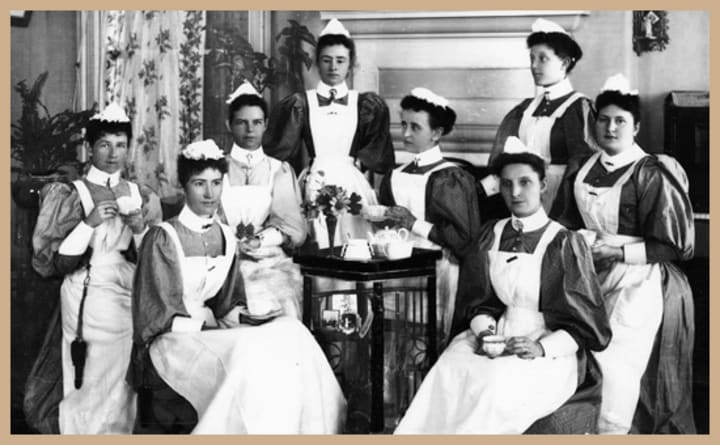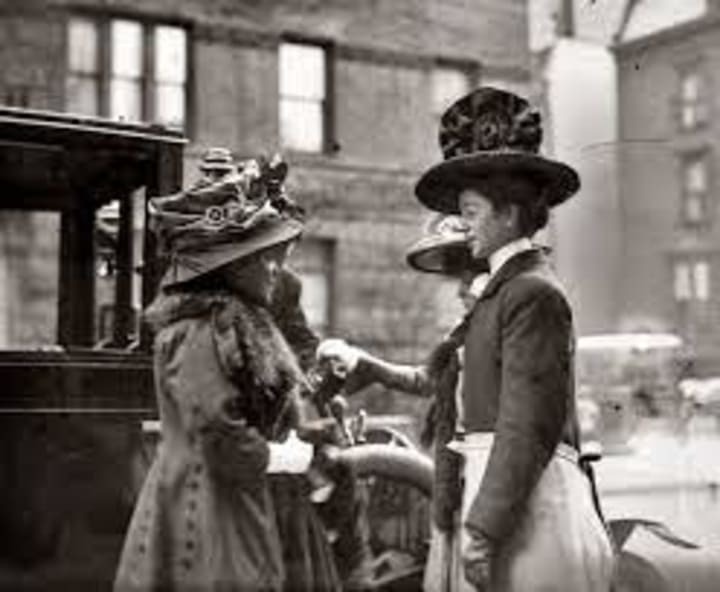Today's Lesson is the Edwardian Era
"I shall go on. I shall work to the end". (Edward VII)

Good Morning, today we will be looking into the Edwardian Era — one of my personal favourites AND one of the most interesting eras in English history.
During this period in history, everyday items that we take for granted today were just being invented and medicine improved tremendously. Fashion changed, mainly for women, as did ‘women's role’ in society. The horse and carriage started to disappear in favour of the motor car and the telephone became the modern means of communication. The new invention called the “Photograph” took sepia pictures of daily life in the Edwardian Era. Also, electricity and indoor plumbing started to become the norm.

Which King and Queen ruled during this time? Queen Victoria died in 1901 and her eldest son, Edward VII, became the King of England, with his wife, Alexandra of Denmark, as his consort. Edward was popular with his people, maybe because he was always thinking about the future. “I can testify to his (Edward VII’s) extraordinary popularity, he was in fact the most popular King England had known since the early 1600's”, remarked J.B.Priestley. The King loved his cars, often driving himself and owning several cars, all of them painted in his own Royal claret colour. Queen Alexandra also owned and drove her own motor cars, making women drivers ‘respectable’.
The Edwardian Era was the link between the old and the modern. The First World War started to break down the class divisions, which ushered in a new and very different society. New Laws were brought in for: shorter working hours, income tax, death duties, old age pensions, unemployment benefit and state financial support for the sick and infirm (which was the beginning of the National Health Service). Even religion was changing, and with Darwinism arriving (in the late 1850’s), the church started to lose its hold on the people.
The Suffragette Movement is one of the main Movements within this Era. Emmeline Pankhurst spearheaded the Suffragettes, travelling the country and giving many speeches, one of her most famous being “Freedom or Death” in 1913. It was during this time, that women of all classes ‘dared to challenge’ what their roles were in society. Some of these women smashed the windows of prominent politicians, and those who were arrested and put in prison went on hunger strike, which did not work because they were force-fed. Emily Davison became famous for throwing herself in front of the King’s horse at the Epsom Derby. She was trampled on and died four days later. The question we have to ask today is: “Did these ladies go too far?” Women do have much more freedom today, but at what cost? Could it have been done another way?
“A hundred years ago, British food was in its Golden Age, with the arrival of the great restaurants, the celebrity chef, exotic new dishes, and gargantuan 12 course meals” (Giles Cohen). The King, of course, led the way, having a ‘good’ appetite and encouraging “Service in the Russian Style” (a la Russe), which meant the different courses were brought to the table (and served). Meal times were changed and smaller meals ‘inserted’ between breakfast and dinner called lunch and afternoon tea (to stop rumbling tummies).
What did the Edwardians eat? For the “Upper class”, the choice was endless. A typical breakfast could consist of: haddock, kidneys, kedgeree, porridge, game pie, tongue, poached eggs, bacon, chicken and woodcock. The “Lower classes” ate a more modest breakfast: bacon, eggs, sausage, fried bread, toast, jam, marmalade, tea, coffee and orange juice. Domestic servants had breakfast, dinner and supper, whereas the “Family upstairs” had breakfast, luncheon, dinner and (often) a late supper. Dinner was always the “most formal meal” for both the Family and the servants.

Domestic Service was one of the main means of employment in the Edwardian Era. Alastair Bruce, who was the historical expert on Downton Abbey, said that: “These people worked from the moment they got up in the morning until they went to bed at night. There wasn’t really time off in the way that we expect today. There is constant activity. The frantic activity downstairs, delivering the calm, peace, serenity of the family who are living in the house”. In the Edwardian Era, you were either a servant or you had servants. It was normal for the working class girl to go straight into Service from school. It was ‘secure’ employment with a bed, good meals and a ‘comfortable living’, and if you could get a position in a ‘big house’, you were looked up to by your friends and family.
Education changed during this Era, with new Laws keeping children in schools longer, so that they could actually learn something. During the previous generation, the Victorian Era, the children born into the poorer families didn’t stand much of a chance. Children as young as five were sent out to earn money for the family basics, and as there were no Laws making it compulsory to stay in school until a certain age, generations grew up not knowing how to read or write.
During the Edwardian Era this changed for the benefit of most “Classes”. Compulsory education started in 1880 when children had to stay in school up until the age of ten. By 1918, this was raised to fourteen years old, giving the future generations a chance. Lessons in reading, writing and arithmetic were regarded as the most important subjects, and added to these were physical education, sewing lessons ‘tailored’ for girls and religious instruction. This was the basic schooling for the lower classes, but it gave these children a chance at a better life. For the upper classes or the wealthy, who could pay for education, their children learnt languages, music, dancing and even science. Today, wealthy or poor, every child has a much better chance of a better life.

There is so much that the Edwardians did for us today, that we could go on for hours. Instead, look out for the next History lesson on the different Eras, as each of them has shaped our lives today.
(If you enjoyed this article, have a look in my profile for more articles on the different Eras)
About the Creator
Ruth Elizabeth Stiff
I love all things Earthy and Self-Help
History is one of my favourite subjects and I love to write short fiction
Research is so interesting for me too
Reader insights
Nice work
Very well written. Keep up the good work!
Top insights
Easy to read and follow
Well-structured & engaging content
Compelling and original writing
Creative use of language & vocab
Excellent storytelling
Original narrative & well developed characters
Eye opening
Niche topic & fresh perspectives
On-point and relevant
Writing reflected the title & theme







Comments (1)
This was a fantastically researched article. Written in a manner which kept me reading from beginning to end. Plus it was the perfect length - long enough to get pertinent information in but short enough to read all the way through in one sitting.